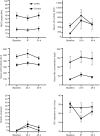Muscle damage in response to a single bout of high intensity concentric exercise in patients with Pompe disease
- PMID: 33842610
- PMCID: PMC8033309
- DOI: 10.21037/atm-20-3114
Muscle damage in response to a single bout of high intensity concentric exercise in patients with Pompe disease
Abstract
Background: In Pompe disease, resistance exercise could be an effective treatment to delay motor function impairment, however, the acute effects of this exercise modality are unclear.
Methods: In a prospective cohort study, we compared responses to a single bout of resistance exercise by serum markers of muscle damage and quantitative muscle magnetic resonance imaging (MRI) in patients (n=12) and age- and gender-matched healthy controls (n=12). Participants performed 50 maximal effort concentric knee flexions on a dynamometer.
Results: Twenty-four hours after exercise, levels of serum creatine kinase, lactate dehydrogenase and myoglobin increased in controls. In contrast, only myoglobin level increased in patients. All elevated serum markers declined by 48 hours after exercise in both groups. Mild soreness developed at 24 hours, which disappeared at 48 hours in both groups. In controls, MRI R2* relaxation rate reduced immediately and 24 hours after exercise, indicating increased water content and muscle perfusion. In patients, exercise had no effect on R2* values. The resistance exercise did not induce acute strength deficit in patients, rather, patients increased their strength by 24 hours. When serum marker changes were normalized to the magnitude of knee flexor tension developed during exercise, lactate dehydrogenase response was greater in patients.
Conclusions: Late-onset Pompe disease did not exacerbate exercise-induced muscle damage, however, lactate dehydrogenase may be monitored to screen high responders during high intensity resistance exercise interventions.
Keywords: Hamstring muscle; Pompe disease; dynamometer; muscle magnetic resonance imaging (muscle MRI); muscle microinjury.
2021 Annals of Translational Medicine. All rights reserved.
Conflict of interest statement
Conflicts of Interest: All authors have completed the ICMJE uniform disclosure form (available at http://dx.doi.org/10.21037/atm-20-3114). SAN reports grants from the New National Excellence Program of the Ministry of Human Capacities (ÚNKP-17-3-III-PTE-315) and a grant from the János Bolyai Research Scholarship of the Hungarian Academy of Sciences. MV reports grants from the Institutional Excellence Program, University of Pécs (17886-4/2018 FEKUTSTRAT) during the conduct of the study. The authors have no other conflicts of interest to declare.
Figures




Similar articles
-
Effects of Kinesio Taping on the Relief of Delayed Onset Muscle Soreness: A Randomized, Placebo-Controlled Trial.J Sport Rehabil. 2019 Nov 1;28(8):781-786. doi: 10.1123/jsr.2018-0040. J Sport Rehabil. 2019. PMID: 30040009 Clinical Trial.
-
Short and longer-term effects of creatine supplementation on exercise induced muscle damage.J Sports Sci Med. 2009 Mar 1;8(1):89-96. eCollection 2009. J Sports Sci Med. 2009. PMID: 24150561 Free PMC article.
-
Indirect evidence of human skeletal muscle damage and collagen breakdown after eccentric muscle actions.J Sports Sci. 1999 May;17(5):397-402. doi: 10.1080/026404199365911. J Sports Sci. 1999. PMID: 10413267
-
Muscle damage and inflammation after eccentric exercise: can the repeated bout effect be removed?Physiol Rep. 2015 Dec;3(12):e12648. doi: 10.14814/phy2.12648. Physiol Rep. 2015. PMID: 26660557 Free PMC article.
-
The effect of branched-chain amino acid on muscle damage markers and performance following strenuous exercise: a systematic review and meta-analysis.Appl Physiol Nutr Metab. 2021 Nov;46(11):1303-1313. doi: 10.1139/apnm-2021-0110. Epub 2021 Oct 6. Appl Physiol Nutr Metab. 2021. PMID: 34612716
Cited by
-
Effects of isometric training and R.I.C.E. treatment on the arm muscle performance of swimmers with elbow pain.Sci Rep. 2024 Feb 27;14(1):4736. doi: 10.1038/s41598-024-54789-0. Sci Rep. 2024. PMID: 38413632 Free PMC article.
References
-
- van den Berg LEM, Favejee MM, Wens SCA, et al. Safety and efficacy of exercise training in adults with Pompe disease: evalution of endurance, muscle strength and core stability before and after a 12 week training program. Orphanet J Rare Dis 2015;10:87. 10.1186/s13023-015-0303-0 - DOI - PMC - PubMed
LinkOut - more resources
Full Text Sources
Other Literature Sources
